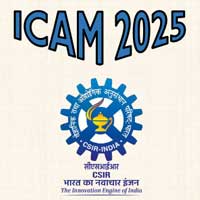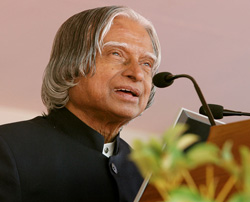DEPARTMENT OF PHYSICS
SCHOOL OF PHYSICAL SCIENCES
St. JOSEPH’S COLLEGE (Autonomous)
Special Heritage Status awarded by UGC, Accredited at ‘A++” Grade ( Cycle-IV) by NAAC
College with Potential for Excellence by UGC, DBT-STAR & FIST sponsored College
TIRUCHIRAPPALLI – 620002, INDIA
Organises
INTERNATIONAL CONFERENCE ON ADVANCED MATERIALS
Jan. 30-31, 2025
Mode of Conduct: Hybrid
About the Institution
St. Joseph's is an autonomous college of the Bharathidasan University, Tiruchirappalli, located in the central part of Tamil Nadu, South India. It was established in 1844 by the Society of Jesus (The Jesuits). The moto of the college is "For the Good and the True". The college celebrated its centenary in 1944, sesqui-centenary in 1995 and Dodransbicentenary in 2019. The college was recognised by UGC as a College with Potential for Excellence (CPE) in 2004 and 2014, NAAC has reaccredited the college at the highest A++ Grade (Cycle-IV) in 2019 and is ranked as 25th position in NIRF India rankings 2024 under college category. St. Joseph's is the only college in Tamil Nadu that has been awarded with Special Heritage Status by UGC. The college trains young men and women of quality to be leaders in all walks of life so that they serve the people of the Nation in truth justice and love. Accordingly, this college strives to be an agent of social change, by incorporating the scientific and technological growth in its UG, PG and Research (M.Phil/Ph.D) programmes.
About the Department
This century-old Department of Physics started B.A. Physics (1881), B.Sc (Hons.) Physics (1911), B.Sc (1930), M.Sc Physics (1961), Ph.D. (1971) and M.Phil (1977). Other than its own evolution, it had given birth to two departments, Computer science (1983) and Electronics (1993) in the college. To cater the needs of the students, BSc and MSc (Physics) programmes in Self-financing section (shift II) were established in 1982 and in 2004 respectively. Presently there are 29 faculties and 9 non teaching staff in the department. The department is constantly developing with the continuous support of management and the funding of UGC, DST-FIST, DST-SERB, DRDO and CSIR. The department had established national and international collaboration in many fields of research in recent years and organises symposia and conferences periodically at all levels to ignite the students with scientific spirit. Over a period of 140 years, the alumni of the department have served and are still serving the nation in various capacities. Notable among them are Bharat Ratna, Dr APJ Abdul Kalam, the former President of India and Dr G N Ramachandran, an Indian Physicist who was known for his work, "The Ramachandran Plot" for understanding peptide structure, nominated for nobel prize (Doctoral student of Nobel laureate Sir C. V. Raman).
Objectives of the Conference
Material Science is a multi-disciplinary branch of science and technology, investigates the relationship between the structure of materials and their micro/macroscopic properties. In recent years with significant focus on Nano Science and Nanotechnology, Material science becomes a more significant field of science and engineering.
This conference highlights the fundamentals, synthesis, characterization, analysis and applications of materials
To create scientific and research temper among the students and researchers through the interaction with the experts in the field
To provide a platform for researchers to share their knowledge and expertise with other researchers of the field
To get exposure to the latest developments in the field of material science from scientists and experts
Focus Area of the Conference
This conference highlights the latest developments, research innovations, and applications in advanced materials and nanotechnology, organized as follows:
1. Nanomaterials and Advanced Materials
Nanomaterials and 2D materials for diverse applications, including 2D layered nanomaterials for biosensors, bioelectronics, and cancer detection
Crystals, Nanocrystal and Colloidal Semiconductor Nanocrystals
Composites and Alloys for industrial advancements
Semiconductors and Superconductors for electronic and quantum technologies
Magnetic and Soft Materials for flexible and wearable technologies
LASER material processing and Nonlinear Optical Materials for communication and sensing
Luminescent and Fluorescent Materials for imaging and display technology
MXene Nanomaterials Fabrication for biomedical applications via electrochemical methods
Eco-friendly Synthesis of Bimetal and Bimetal Oxide Nanoparticles and Tri-metal Oxides/Bimetal Chalcogenides for electro/photo catalytic applications
Ultrashort laser-matter Interactions & Materials Processing
2. Bio-Nanomaterials and Biomedical Applications
Organic and Biological Materials for healthcare innovations
Bio-Nanomaterials for medical applications, including Nanodrug Delivery and Nanomedicine
Biosensors for health and environmental monitoring
Materials for Nuclear Reactors and Space Applications
Flexible Biosensors and Field-Effect Transistor (FET) Biosensors for DNA/RNA detection, bioelectronics, and cancer biomarkers detection
Real-time Applications of Electrochemical Biosensors for Biological Sample Analysis
3. Energy and Storage Materials
Nanomaterials for Energy Generation and sustainable technologies
Advanced materials for Energy Storage Solutions, including supercapacitors, sodium-ion batteries, and materials for Hydrogen Evolution Reaction (HER) and Oxygen Evolution Reaction (OER)
Fabrication of High-Performance Electrochemical Devices for green energy applications
Electrochemical Supercapacitors, including symmetric and asymmetric supercapacitor devices and performance characterization
4. Environmental and Agricultural Impact
Harmful Effects of Nanoparticles in the environment and on plant life
Nanotechnology for Agriculture, including Nano Foods for Space Applications and crop enhancement
Photocatalytic Degradation of environmental pollutants in river water
Electrochemical Applications for Food and Water Analysis
5. Modeling and Simulation
Mathematical and Simulation Models for understanding material properties
Studying the behavior and interactions of nanomaterials at atomic and molecular scales
Toxic chemical detections and degradation using Photodegradation Methods
GET IN TOUCH
0431-2700320/4226436 college@mail.sjctni.edu www.sjctni.edu St.Joseph's College (Autonomous),Tiruchirappalli-620 002,
Tamilnadu, India.









